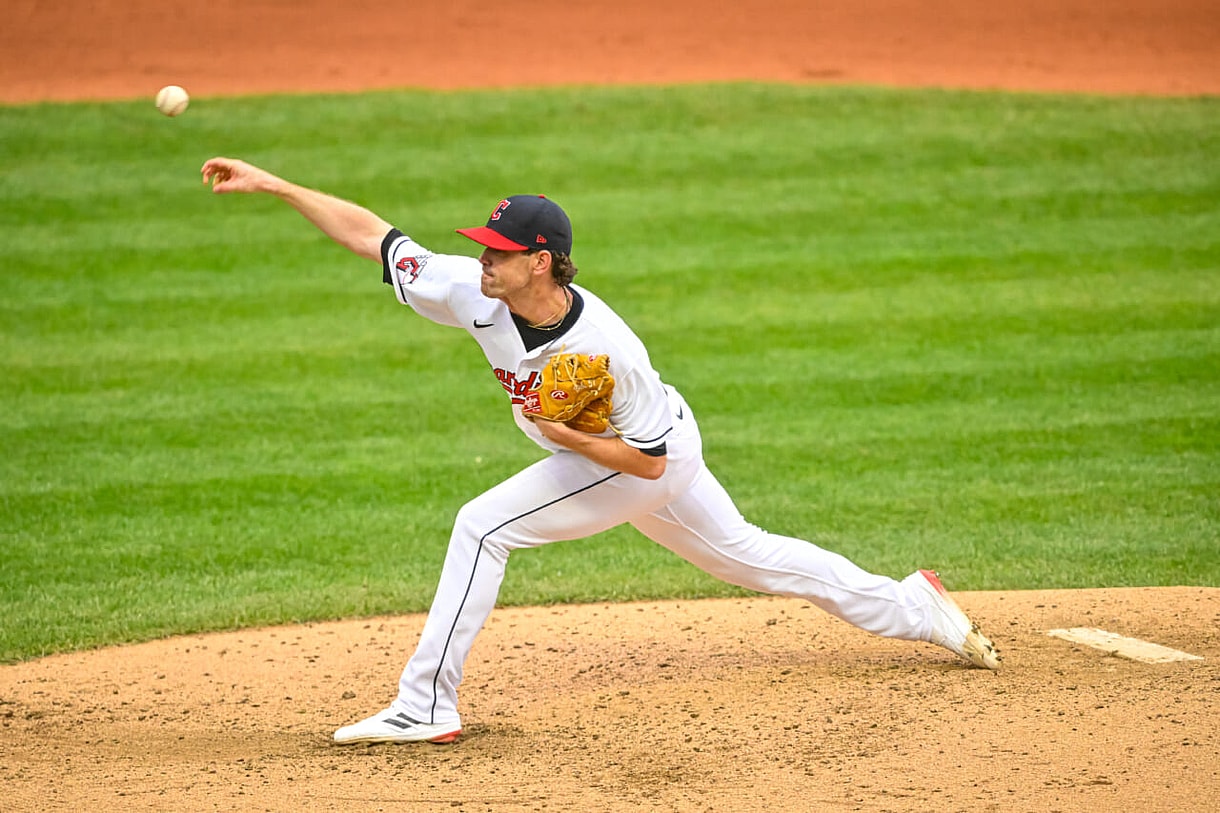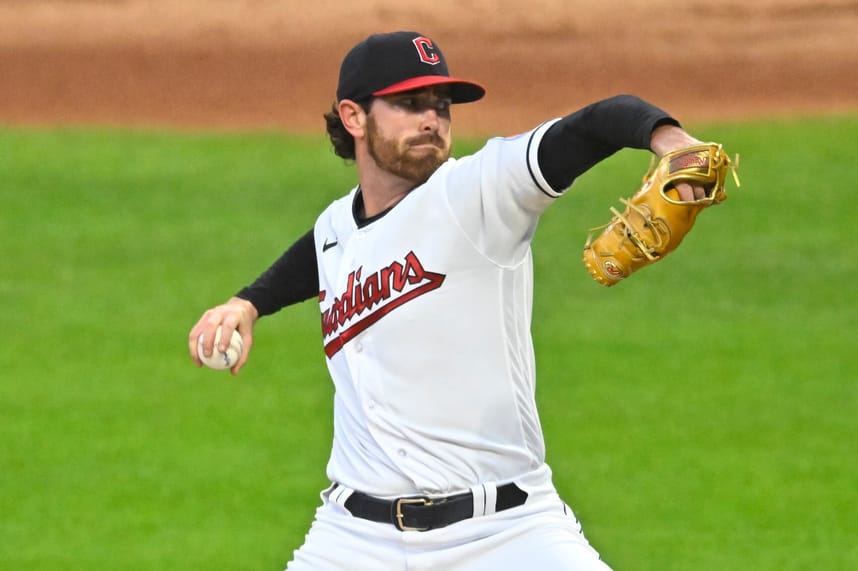
While the Yankees are locked in a tight race for the services of Yoshinobu Yamamoto, the trade market has seen its first domino fall. Jack Azoulay-Haron of MLB Nerds reported earlier this week that the Dodgers were on the verge of acquiring Tyler Glasnow from the Rays, a monumental upgrade for their depleted staff. Another name who’ll likely be dealt is Dylan Cease, although those conversations have stalled as the White Sox wait for the Yamamoto sweepstakes to come to an end.
A name with more buzz surrounding him as of late is right-hander Shane Bieber, who the Yankees could land at a lower cost this season, especially with some work being done at Driveline this winter.
Can We See Shane Bieber’s Four-Seamer Return to Form?

You could make a reasonable argument that the decline of Shane Bieber from his ridiculous 2020 season has come from his four-seam fastball withering into a below-average pitch. While his breaking stuff and command have always been the variables that made him elite, a good fastball elevates an arsenal, but declining velocity has completely sapped Bieber of the once-dominant fastball he possessed. In his Cy Young campaign, Bieber had a +1.2 Run Value per 100 pitches on his fastball, and since then, it’s declined to just 0.2 Run Value per 100.
While in 2020 Bieber had a four-seamer with a 105 Stuff+, that number has dropped to just 82 over the past two seasons, taking it from an above-average pitch (55) to a below-average one (35/40) in its shape. He’s still maintained good vertical carry on the pitch, but without the ability to generate swings-and-misses, it’s caused his strikeout rate to drop every season since his peak year. The first conclusion people have reached pertains to the foreign substance scandal, assuming that Bieber’s decline had to do with a crackdown on pitchers using these sticky substances.
The easiest way to measure this would be by identifying spin rates, and while Bieber’s have made a sharp decline, we also know that velocity plays a role in spin. We can view spin as a force imparted on the baseball, and a greater force on the ball is easier to create when it’s being thrown harder, so we’d have to adjust for that decrease in velocity as well. Bauer Units are a metric that divides spin rate (RPM) by velocity (MPH), with 24.2 as the league average in 2023.

Shane Bieber’s Bauer Units this past season were above average, and while there is a one-unit drop from his peak in 2021, a gap of under 0.5 units separates his 2023 and 2020 seasons. As mentioned earlier, Bieber is going to Driveline this offseason, a training facility that’s known for improving velocity for pitchers, something that could get Bieber back on track. Doubts about relying on a pitcher to improve to make them worth acquiring are fair, but given the Yankees’ lack of options, if they miss out on Yoshinobu Yamamoto, he could be their best bet.
If we see a return to the velocity he possessed in 2019 or 2021 (~93 MPH), then Bieber would likely see a return to 18″ of vertical carry instead of the 17″ we saw this past season. That alone could give a fastball better play up in the strike zone, and given Bieber’s excellent command, having an average fastball could uplift the rest of his arsenal enough for him to rank closer to the top 15 or 20 in terms of production. Cleveland has a great history of developing pitching, and Bieber wasn’t in a bad situation to make said improvements, but sometimes, a change of scenery can do an athlete well.
Health is another question for Bieber, who missed plenty of time in 2023 with an elbow injury that limited him to just 128 innings, and this is after having shoulder issues back in 2021. The 200 innings in 2022 would lead one to believe that the ‘injury-prone’ would be too harsh, and he still averaged over six innings a start this past season, showing an ability to work deep into games. Improved velocity and consistent health could help Bieber get some of those strikeouts back, but another part of this equation is re-discovering comfort with arguably his best strikeout weapon.
- 3 things the Yankees should have on their offseason wish list for 2026
- Yankees eyeing outfielder Austin Hays as a fallback option in free agency
- Why the Yankees might have a superstar on their hands with Ben Rice
Relying More on His Breaking Pitches Once Again

One of the most head-scratching decisions made by Shane Bieber this past season has to do with his breaking ball usage, which also played a role in fewer whiffs. After throwing breaking pitches nearly half the time in 2022 (47.4%), Bieber increased the usage of his cutter, a change that came at the start of the season and weirdly stuck all year. It’s no secret that his slider and curveball are his two best pitches, they generate plenty of swings and misses alongside softer contact than the fastball, and while his cutter was a strong pitch in 2022, it regressed hard with a higher dose of them thrown.
Shane Bieber’s slider has improved on the one thrown in 2022, with similar velocity but some added depth while not losing any horizontal movement. As a result, it’s increased in Stuff+ by 13 points to 111, and while the whiffs on the pitch were down, so was the usage. It’s not often that a pitcher’s best pitch the year prior improves in shape and then sees a decrease in usage, and that’s an area of immediate improvement that you could see in 2024. It also helps his four-seamer and cutter, as those two pitches set up that knockout slider at two strikes.
This sequence from 2022 alone shows the upside of a pitcher who can tunnel extremely well, and that’s with a fastball that had diminished to just an 82 Stuff+ that year. Even without gains in velocity, we’ve seen how good he can be just based on the command of his secondaries alone, sporting a 77 ERA- and using his slider 29.5% of the time that season, making it by far his second-most used pitch. His curveball had served as his tertiary pitch that season, and while it had been his secondary offering in 2020 and 2021, the slider had emerged in its place.
Shane Bieber used his curveball heavily against left-handed hitters, sporing a .213 wOBA and 40.7% Whiff Rate while promoting contact in the ground as well. His Bauer Units were hurt on the curveball following the substance ban, but decreasing the usage of that pitch from 2022 to 2023 when it had been a +8 Run Value pitch for him is another decision that just doesn’t make much baseball sense. The easiest way to prevent damage contact as a pitcher is to avoid allowing any contact at all, and yet Bieber opened himself up to more batted balls this past season.
Dropping his usage of breaking balls by over 10% with their success could explain the sudden lack of swings and misses, as in terms of Stuff+ and velocity, everything remained unchanged from his incredible 2022. What’s odd is that the Guardians have seemingly shifted away from promoting whiffs, as while they were second in strikeout rate (25.6%) from 2016-2020, they have dropped to 19th (22.6%), and pitchers like Aaron Civale have left Cleveland and generated more whiffs.

Under Matt Blake, the Yankees have been tied for third in strikeout rate (24.8%) and, as a result, have had the fifth-best ERA (3.75) in baseball. What’s also relevant is the connection from Blake to Bieber, as the Yankees’ pitching coach had been in Cleveland since 2015, spending time as their Assistant Pitching Coordinator from 2016 to 2019, overseeing arguably Bieber’s two best seasons in the Majors. Shane Bieber credited Matt Blake for his heavier reliance on the curveball in 2019, which caused his emergence into a top-flight starter.
With 259 strikeouts in 214.1 innings that season, Bieber sported a 3.28 ERA (71 ERA-) and 5.5 fWAR, which led to him finishing fourth in the AL Cy Young voting that season. Could that connection between the two results in a greater emphasis on using his breaking balls in the Bronx? Maybe, and while Bieber is a different pitcher than he was in 2019, at the very least, we’ve seen his formula for success on decreased velocity, and it’s a matter of getting back on that track.
The last question that remains stems from what Shane Bieber would cost on the trade market and whether the Yankees have what Cleveland would be looking for.
Do the Yankees and Guardians Match Up Well in a Deal?

The Guardians need offense, and most notably, they need power, as this past season, they were 27th in Runs Scored (662) and 29th in SLG% (.381). Outfield help seems to be a consistent issue for the Guardians, and the first name that comes to mind in a potential deal is Everson Pereira. Whiffs are a big issue in Pereira’s game, but at just 22 years old and with plenty of power, the Guardians could target him as a solution in the corner outfield to help give them an extra power bat in his pre-arbitration years.
My initial apprehension is trading a top-100 prospect for one year of a pitcher with diminishing returns, as while there are reasons to believe in a bounceback season, there’s still a three-year stretch of consistent regression. It may seem stingy, but if you’re trading six years of an outfielder with upside to be a good hitter with strong corner outfield defense, it’s not for a pitcher who has been headed in the wrong direction for a large sample size.
One could reasonably argue that dangling Alex Verdugo instead, a one-for-one swap of players on expiring contracts following down seasons, but there’s an immediate hold-up there. Brian Cashman outlined that the Yankees had tried to trade for Alex Verdugo on multiple occasions, and they’ve been reported to want to hang onto him for the season. Perhaps Trent Grisham, who has two years of control and is a Gold Glove outfielder, could entice the Guardians, but they’re a cheaper team likely searching for talent they can build around.
When looking for immediate answers to a trade, either the Yankees would have to feel comfortable parting ways with Everson Pereira for one year of Shane Bieber, or they’d likely have to ask Cleveland to add to the deal. These two sides could match up in a trade, but for the Yankees, their priority needs to be Yoshinobu Yamamoto. Similarly to their acquisition of Juan Soto over Cody Bellinger, the fanbase wants to rally behind a move that doesn’t require hedging your bet on a player with red flags for regression, especially when it’s a potential overpay.
As a talent, Shane Bieber makes plenty of sense for the Yankees, but in terms of a potential trade, the Yankees would be once again taking quite the risk to make a move that could blow up in their face. Michael Marino on our Fireside Yankees podcast mentioned not seeing much buzz around the Yankees and a potential trade on the rental market on the pitching side, an indication that this isn’t an avenue they’ll explore. What are its chances of happening this winter? I’d say it’s sitting at pretty unlikely.
More about: New York Yankees